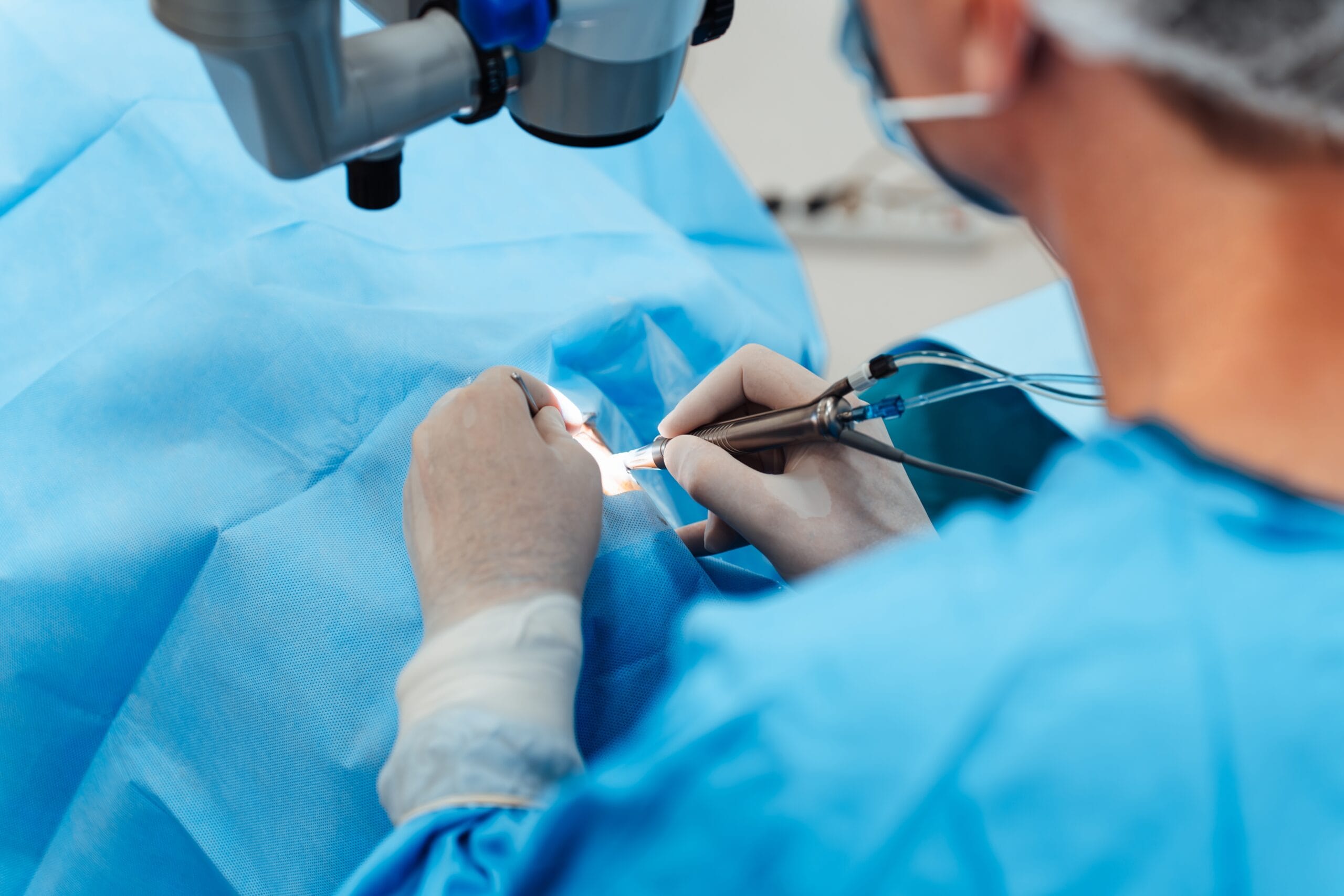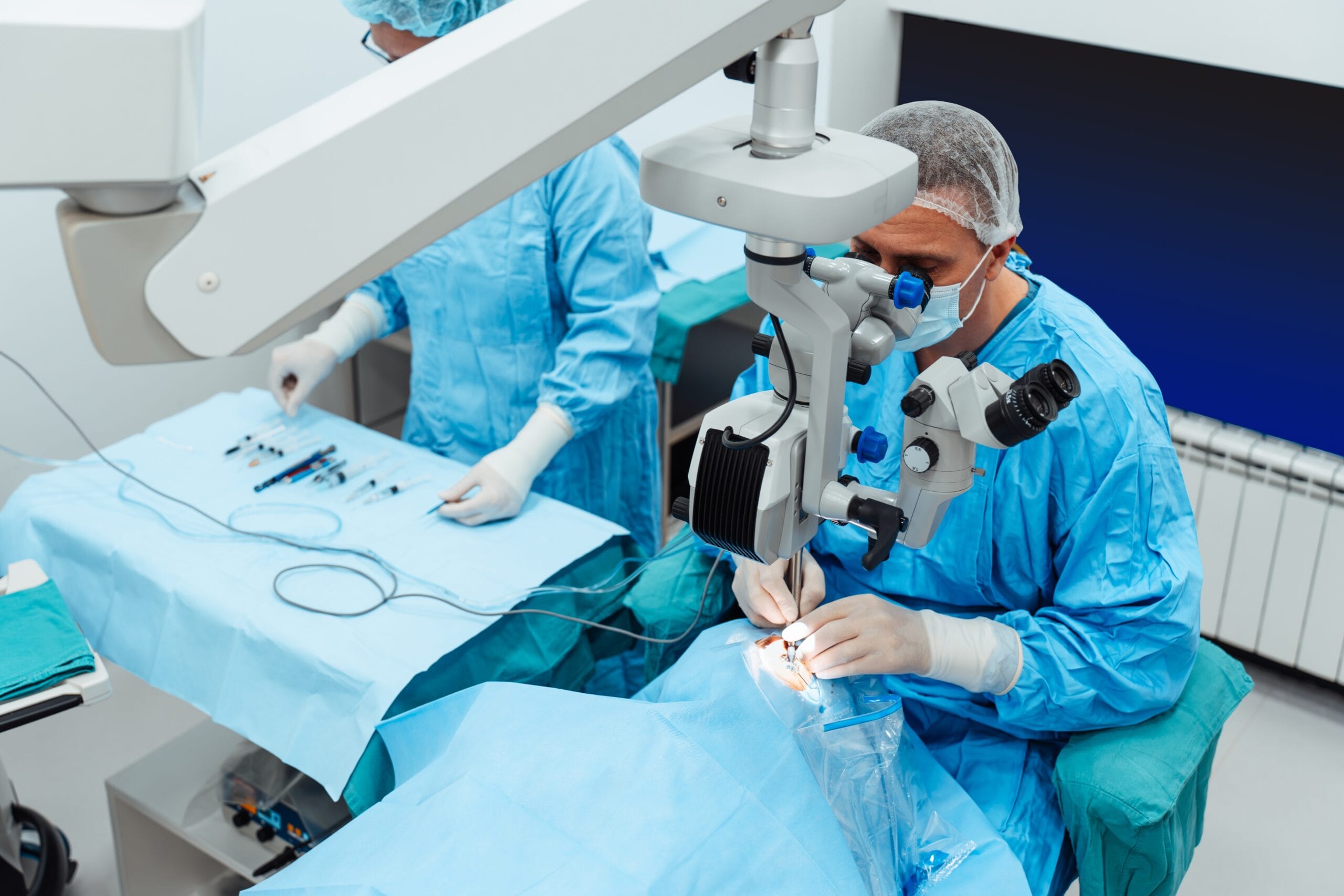If you’re considering cataract surgery, understanding the complete timeline from preparation through recovery can help ease any concerns you might have. While the procedure itself typically takes just 10-15 minutes per eye, there’s more to know about the entire process.
We’ll walk you through everything you need to know about cataract surgery timing, from your first consultation to your final follow-up appointment. Our comprehensive guide will help you prepare for each stage and know exactly what to expect.

Understanding Cataracts
A cataract occurs when the natural lens in your eye becomes cloudy, similar to looking through a foggy window. This cloudy vision develops gradually over time and can affect one or both eyes, leading to blurry vision, difficulty reading, and problems with night driving. As cataracts progress, they can significantly impact your daily activities and quality of life.
Causes of Cataracts
- Age-Related Changes: The most common cause of cataracts is the natural aging process, typically affecting people over 60. Proteins in your eye’s lens break down and clump together, creating cloudiness.
- Medical Conditions: Diabetes and high blood pressure can accelerate cataract formation. These conditions affect blood flow to your eyes and can damage the lens tissue.
- Lifestyle Factors: Smoking, excessive alcohol consumption, and prolonged sun exposure without UV protection can increase your risk of developing cataracts earlier in life.
- Medications: Long-term use of certain medications, particularly corticosteroids, can contribute to cataract formation.
Signs of Cataracts
- Persistent Blurry Vision: Your vision remains cloudy or blurry even with updated prescription glasses or contact lenses. This impacts your ability to read, watch TV, or recognize faces clearly.
- Double Vision: You experience double vision in one eye, making it difficult to perform detailed tasks or drive safely.
- Difficulty with Night Activities: You struggle with night driving due to increased glare from headlights and street lamps. Colors may also appear faded or yellowed.
- Impact on Daily Life: Your vision problems interfere with routine activities like reading, cooking, or enjoying hobbies. This significant impact on quality of life often indicates it’s time for cataract surgery.
Pre-Surgery Timeline: What to Expect
The preparation phase for cataract surgery typically spans several weeks. During this time, your eye doctor will conduct thorough evaluations and help you prepare for the procedure. Understanding this timeline helps ensure the best possible outcome for your cataract surgery.
- Initial Consultation (2-3 weeks before cataract surgery) – Your eye doctor will perform a comprehensive eye exam and discuss your medical history. They’ll evaluate the severity of your cataracts and determine if you’re a good candidate for cataract surgery.
- Measurements and Testing (1-2 weeks before cataract surgery) – Special tests will measure your eye’s size and shape to determine the right type of artificial lens. Your doctor will also perform corneal mapping and other diagnostic tests to plan the procedure.
- Medication Review (1 week before cataract surgery) – Provide a complete list of your medications to your doctor. They may ask you to temporarily stop certain medications that could increase bleeding risk.
- Pre-operative Instructions (2-3 days before surgery) – You’ll receive specific instructions about eating, drinking, and medication use before surgery. Your doctor will prescribe antibiotic eye drops to start using a few days before the procedure.
- Day Before Preparation – Arrange for someone to drive you home after surgery. Follow any fasting instructions and ensure you have all necessary eye drops ready.
The Day of Surgery: Step-by-Step Timeline
- Arrival and Check-in (2-3 hours before cataract surgery) – You’ll arrive early at the surgical center to complete paperwork and prepare for the procedure. Wear comfortable clothing and avoid eye makeup or facial products.
- Pre-operative Preparation (30-45 minutes) – The medical team will dilate your eye and administer pre-operative eye drops. They’ll check your vital signs and review your medical history one final time.
- Local Anesthesia Administration (10-15 minutes) – Your eye will be numbed using special eye drops or a local anesthetic injection. Most patients remain awake but feel no pain during the procedure.
- The Surgery (10-15 minutes) – During cataract surgery, your surgeon will remove the cloudy lens and replace it with a clear artificial one. The procedure is precise and relatively quick, using advanced microsurgical techniques.
- Initial Recovery Period (15-30 minutes) – You’ll rest in a recovery area while the medical team monitors your condition. They’ll provide initial post-operative instructions and ensure you’re responding well to the procedure.
- Discharge Process (15-30 minutes) – Before leaving, you’ll receive detailed care instructions and prescriptions for eye drops. Your designated driver can then take you home to begin recovery.
The actual cataract surgery procedure typically takes only 10-15 minutes per eye, making it one of the quickest vision correction surgeries available. During this brief period, your surgeon uses advanced microsurgical techniques to remove your cloudy natural lens and replace it with a clear artificial one. While the surgery itself is quick, you should plan to spend 2-3 hours at the surgical center for preparation and initial recovery.
Recovery Timeline and Post-Surgery Care
Your recovery from cataract surgery follows a specific timeline, with most patients experiencing notable vision improvement within the first few days. Understanding what to expect during each phase helps ensure a smooth healing process. Let’s break down the recovery timeline and essential care instructions to help you achieve the best possible outcome.
- First 24 Hours After Cataract Surgery: The initial recovery period is crucial for proper healing. You’ll need someone to drive you home and help you follow basic care instructions. Use prescribed eye drops as directed and keep your protective eye shield in place, especially while sleeping.
- Days 2-3 Post-Surgery: Your first follow-up appointment typically occurs during this period. While you may notice improved vision, some blurriness or mild discomfort is normal. Continue using eye drops and avoid touching or rubbing your eye. Light activities are permitted but avoid bending or straining.
- Week 1 Recovery Period: Most patients return to basic daily activities but should still avoid strenuous exercise and heavy lifting. Your vision will continue improving, though you might experience some fluctuation. Protect your eye from water while showering and wear sunglasses outdoors.
- Weeks 2-4 Healing Phase: By now, most daily activities can resume, except swimming and high-impact exercises. Your vision should be noticeably clearer, though complete stabilization may take a few more weeks. Continue your eye drop regimen as prescribed and attend scheduled follow-up appointments.
- Long-term Recovery (1-2 Months): Most patients achieve their final vision improvement by this time. If you need cataract surgery in your other eye, your doctor will typically schedule it during this period. You can resume all normal activities, including swimming and exercise, with your doctor’s approval.
- Follow-up Care Schedule: Maintain regular check-ups as recommended by your eye doctor. These visits ensure proper healing and address any concerns. Your doctor will determine if you need vision correction for reading or other activities during these appointments.
- Ongoing Eye Health Maintenance: Protect your investment in better vision by scheduling regular eye exams. While artificial lenses don’t develop cataracts, other eye conditions can still occur. Use proper eye protection during activities and maintain good eye health practices.
Managing Double Vision and Blurry Vision After Surgery
Blurry vision after cataract surgery is a normal part of the healing process as your eye adjusts to the new artificial lens. Your brain needs time to adapt to the clearer images being received, and the small incision in your eye needs to heal. Most patients notice significant improvement in their vision within a few days, though complete stabilization may take several weeks.
Common Vision Changes
- Blurry Vision: Your vision may be cloudy or wavy for the first few days as your eye heals and adjusts to the new lens. This is temporary and typically improves quickly.
- Double Vision: Some patients experience mild double vision initially as your brain adapts to processing images through the new lens. This usually resolves within a week.
- Light Sensitivity: You might find bright lights uncomfortable or notice more glare than usual. This sensitivity typically decreases as your eye heals.
- Color Changes: Colors may appear brighter or more vivid because your new clear lens allows more light to enter your eye. Your brain will adjust to these enhanced colors over time.
Tips for Managing Vision During Recovery
- Lighting Adjustments: Use good lighting for reading but avoid very bright lights. Consider wearing sunglasses outdoors to reduce glare and protect your healing eye.
- Activity Modification: Take frequent breaks during detailed tasks like reading or using digital devices. This helps reduce eye strain during the healing process.
- Follow Medication Schedule: Use your prescribed eye drops exactly as directed. These medications help prevent infection and reduce inflammation for optimal healing.
- Rest Your Eyes: Give yourself permission to rest your eyes throughout the day. If you experience discomfort or strain, close your eyes for a few minutes.
The Benefits of Cataract Surgery
Section
Cataract surgery significantly enhances your ability to see clearly at all distances, depending on the type of artificial lens you choose. Many patients report that colors appear more vibrant and details are sharper after cataract surgery. This improvement in vision clarity can help you return to activities you might have given up due to poor eyesight.
Enhanced Quality of Life
After recovering from cataract surgery, most patients experience a dramatic improvement in their daily activities. You’ll likely find it easier to read, watch television, and recognize faces. Many people also report increased confidence in driving, especially at night, when glare and halos from lights are reduced.
Greater Independence
With clearer vision, you can maintain your independence and continue enjoying your favorite activities. Many patients find they can return to hobbies they had abandoned due to poor vision, such as reading, crafting, or playing sports. This renewed independence often leads to increased social engagement and overall life satisfaction.
Improved Safety
Better vision after cataract surgery can significantly reduce your risk of falls and accidents, particularly in older adults. Clearer vision helps you better navigate your environment, see obstacles, and maintain your balance. This improvement in safety can help you maintain an active lifestyle with greater confidence.
Conclusion
Cataract surgery is a brief but transformative procedure that typically takes just 10-15 minutes per eye. While the surgery itself is quick, understanding the complete timeline from preparation through recovery helps you set realistic expectations and achieve the best possible outcome. Following your doctor’s instructions and being patient during the healing process are key to success.
Your journey to clearer vision through cataract surgery involves several stages, but most patients find the process straightforward and well worth the effort. With proper care and attention to your recovery timeline, you can look forward to improved vision and enhanced quality of life within a few weeks after your procedure.


